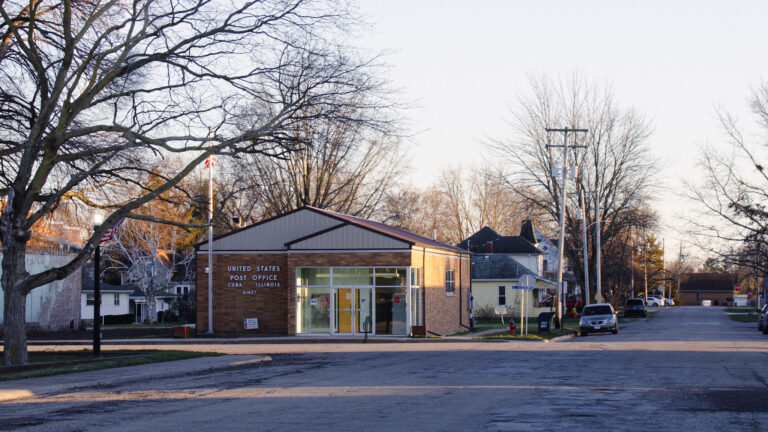CUBA — Nestled between vast stretches of cornfields in western Illinois, Cuba is home to about 1,100 people.
It is also 95 percent white, according to the last U.S. census. Once in a while, Cuba High School history teacher Joe Brewer’s students ask him why.
“My students want to ask about lynchings in the area,” Brewer said. “It’s difficult for folks to talk about still, but those are the exact questions my students want to address.”
When Illinois lawmakers expanded the Black history curriculum required to be taught in public schools, part of the goal was building empathy among non-Black students.
Chicago Representative LaShawn K. Ford helped pass the law in 2021. At the time, he said community members wanted more education on who Black people were before they were enslaved.
“The community felt that if we want to make sure that we treat people right, we should know where they come from,” Ford said on the 21st talk show.
Most schools in Illinois are majority white, especially in rural areas.
Illinois Public Media’s two-part series dives into how a teacher tackles race and sexuality in a rural classroom. You can find the second piece on sexuality here.
Was Cuba a sundown town?

One sunny day in March, Brewer was guiding his students through the evidence to determine whether their town had been welcoming to African Americans during the 1920s.
He showed them population totals from 1910, when Cuba hit an all-time high of 2,000 people.
“And then look what happened 10-years later. In 1920, we go from 68.5% growth – never seen that before – to all of a sudden 26.5% decline, in one census.”
The next slide includes notes from James Loewen, one of the country’s top experts on sundown towns, places where African Americans were warned to leave before nightfall. The census irregularity brought him to Cuba to interview residents.
Brewer asked his class to read Loewen’s conclusion on whether Cuba was a sundown town: probable.
“If you’re going to a murder trial, and you’re finding out whether Cameron committed the murder and the jury comes back and says probable? He probably did,” Brewer explained. “I’m pretty sure he did it, but I just don’t have enough evidence.”
Sundown towns sometimes meant racial violence

Loewen has since passed away, and others have picked up where he left off.
According to former Southern Illinois University sociology professor Jessica Crowe, some sundown towns drove out existing Black residents, and others set up formal or informal laws warning new Black migrants from the South not to settle in.
“People who live there still remember the signs that were posted on the edge of the town’s city limits. And these signs would say different things. But they all had the same theme where they would say to the racial group, do not let the sun set down on your head in this town,” Crowe said.
Crowe grew up in a documented sundown town, Pana, Illinois. In 1899, five Black people and two white people were killed in conflicts over mining jobs. Afterwards, other Black residents were violently expelled.
The town is still 97 percent white, according to the U.S. Census, and Crowe said she barely learned about race in school.
“You go to college, and there are all these people that are not white. How do I interact in that social setting? How do I not offend people? I made some big mistakes,” Crowe said.
Crowe said she used words no one had ever told her were offensive. She corrected her mistake afterwards but wishes she had learned more when she was younger.
Can education prevent racism?
Crowe felt more education about race could have prevented some of her embarrassing mistakes. Is that true on a larger scale – can education prevent racism?
According to Canadian psychology professor Dr. Iloradanon Efimoff, it can. She published a study in 2023 on experiments conducted with introduction to psychology students.
“We found that any type of learning was better than no learning,” Efimoff said.
After teaching about racism over the span of a few months, the students did show more knowledge about Indigenous people and were more empathetic towards them.
She said learning about racism as a system that advantages white people over Indigenous people in Canada worked better over time than learning about racism as a negative bias against a group of people.
Efimoff hypothesized why learning about individual racism decreased participants’ awareness of white privilege.
“We’re centralizing racism within a person as something abnormal about that person who holds racist attitudes, or racist beliefs So that helps us to kind of ignore the system. And it also helps participants to go, ‘Well, I’m not racist,’” she said.
Over time, all participants forgot some of the knowledge they had learned and lost some of the empathy they had gained. Efimoff says long-term learning, like lessons over multiple years in school, is necessary to prevent that loss.
Joe Brewer has high hopes for his students.
“Democracy should be born anew in each generation. What do they want school to look like? What did they want these communities that are really struggling, that are aging, to look like?”
Students: “If white people feel uncomfortable, they won’t want it to happen again”

As class was ending that sunny day at Cuba High School, Brewer asked his students for help. He wanted them to weigh Cuba’s history as a probable sundown town against other evidence, like its location within the underground railroad that helped enslaved people to freedom.
“Can you help us solve this mystery? There really is no consensus on it. What were we during the Great Migration? Were we part of the communities that welcomed people?” Brewer asked.
Junior Samantha Thum decided Cuba may have been relatively welcoming.
“Compared to other places in Illinois, maybe we were. But I don’t really know if anybody was welcoming then, especially white people. At that time, it was hard to find welcoming white people,” Thum said.
She said even if truths like these are uncomfortable to white students, they are important to learn.
“If white people, for example – who have been the ones that put African Americans in that position – feel uncomfortable, then they won’t want it to happen again,” she said.
Emily Hays is a reporter for Illinois Public Media.

